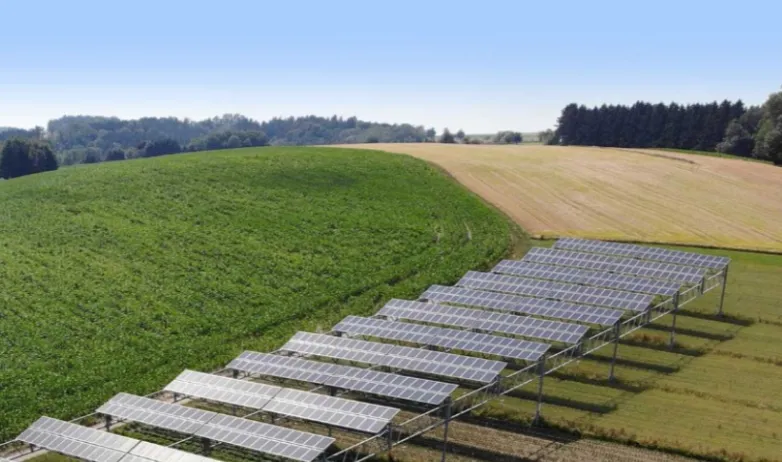Combining Solar & Farming Benefits Both
Sep 9, 2019 08:39 PM ET

Fraunhofer ISE in Germany was one of the first to experiment with combining solar and farming on the same land. Its early research found doing so increases the productivity of the land significantly — up to 60% or more in some cases.
Now researchers at the University of Arizona have confirmed the benefits of growing crops beneath the shade provided by solar panels — more electricity, higher yields, and less water used. That last part is of vital interest to farmers in Arizona where access to water for irrigation is crucial.
“Many of us want more renewable energy, but where do you put all of those panels? As solar installations grow, they tend to be out on the edges of cities, and this is historically where we have already been growing our food,” says Greg Barron-Gafford, an associate professor at the University of Arizona School of Geography and Development and lead author of a report published in Nature Sustainability.
“So which land use do you prefer — food or energy production? This challenge strikes right at the intersection of human-environment connections, and that is where geographers shine!” he says. “We started to ask, ‘Why not produce both in the same place?'”
The researchers set up three parcels of land for the experiment. One was used exclusively for growing crops, another for solar panels, and a third parcel that combined the two. Three crops were chosen — chiltepin peppers, jalapeno peppers, and cherry tomatoes.
According to Science Daily, the researchers continuously monitored incoming light levels, air temperature, and relative humidity. Both the traditional planting area and the agrivoltaic system received equal irrigation rates and were tested using two irrigation scenarios — daily irrigation and irrigation every second day.
A Win For Crops
“We found that many of our food crops do better in the shade of solar panels because they are spared from the direct sun,” says Baron-Gafford. “In fact, total chiltepin fruit production was three times greater under the PV panels in an agrivoltaic system, and tomato production was twice as great!” Jalapenos produced a similar amount of fruit in both the agrivoltaics system and the traditional plot, but did so with 65% less transpirational water loss.
“At the same time, we found that each irrigation event can support crop growth for days, not just hours, as in current agriculture practices. This finding suggests we could reduce our water use but still maintain levels of food production,” he added, noting that soil moisture remained approximately 15% higher in the agrivoltaics system than the control plot when irrigating every other day.
A Win For Solar
As solar panels heat up, their efficiency decreases. By cultivating crops underneath the PV panels, researchers were able to reduce the temperature of the panels.
“Those overheating solar panels are actually cooled down by the fact that the crops underneath are emitting water through their natural process of transpiration — just like misters on the patio of your favorite restaurant,” Barron-Gafford says. “All told, that is a win-win-win in terms of bettering our how we grow our food, utilize our precious water resources, and produce renewable energy.”
Based on the temperature-efficiency curves of these solar panels, the researchers calculate those cooler temperatures should increase electricity generation by about 3% over the summer months, averaging out to a 1% gain for the whole year, according to ArsTechnica.
Other Benefits
Barron-Gafford’s research has expanded to include several solar installations on Tucson Unified School District land. Moses Thompson, who splits his time between those public schools and the university, notes that engaging the public school students has its own benefits. “What draws me to this work is what happens to the K-12 learner when their involvement is consequential and the research lives in their community,” he says. “That shift in dynamics creates students who feel agency in addressing grand challenges such as climate change.”
The research also suggests cooler temperatures under solar panels could protect farm workers from too much exposure to the sun. “Climate change is already disrupting food production and farm worker health in Arizona,” said Gary Nabhan, an agroecologist at the University of Arizona’s Southwest Center and a co-author on the study. “The Southwestern U.S. sees a lot of heat stroke and heat-related death among our farm laborers. This could have a direct impact there, too.”
The Takeaway
Does this research mean all agriculture should be carried out beneath solar panels? Of course not. The researchers are working with the National Renewable Energy Laboratory to study how to expand agrivoltaics to other crops and other areas. It will be no panacea but it could have one very important benefit for farmers.
The income earned from leasing their land to solar energy companies could make the difference between continuing in the farming tradition or selling out. Farming communities are already under stress from climate change related factors — flooding, rising temperatures, and drought among them. A synergy between agriculture and solar generation could be the lifeline they need to preserve their livelihood.
Also read
- Fast Prototyping Boosts Solar Efficiency and Sustainability
- 5 Practical Solar Solutions for Modern Technology Needs
- Understanding Renewable Energy Infrastructure - New Trends in Technology
- Wiltshire Solar Solutions Explained: Benefits for Local Homeowners
- Exploring the Key Players in Dubai’s Solar Panel Distribution Market

